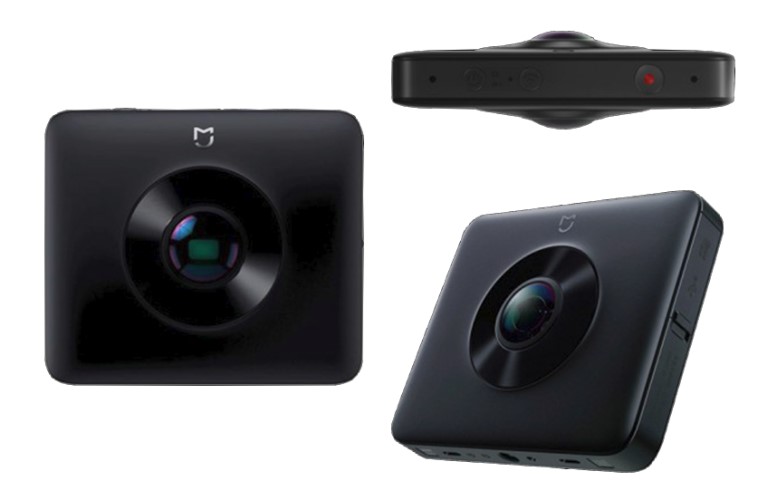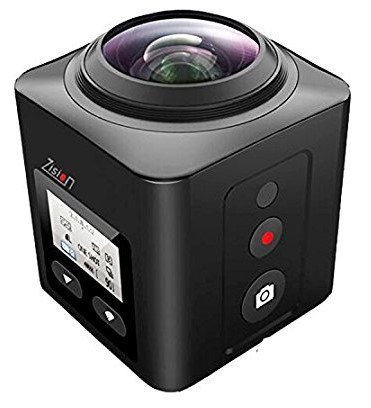There are lots of commercial applications for filming sex with 360 degree cameras, but they could also be a boon for private sex filming in ways that might surprise you. We’ll talk about both applications this month.
The big news is the dramatic decrease in price. These cameras are now surprisingly affordable, with budget models at around $100.
First we’ll cover applications for couples interested in recording their sexual activity in a new way. At first thought, this seems a bit pointless. It is just the two of you, and who needs to see the rest of the room? That is technically true, a problem also with a lot of professional porn applications. Why let you look around when there is nothing to see?
However, when you are having sex, you don’t always stay in one place and one position. With a 360 degree camera (or 240 or 180 for that matter), you don’t need a cameraman to follow you around. Most couples would rather not have a third person there, and for couples that adventurous, they might want to have that third person join in on the action.
What you can do is record the video with a 360 camera, and then easily edit it into a standard HD 16:9 format. At the bottom end you are not going to get 3D, and without that it is not a particularly great format for actual VR with goggles. It works fine for conversion, though.
I use Cyberlink’s PowerDirector 16 Ultimate. It makes it easy to convert 360 videos to regular video, but it is also an amazingly powerful video editor with high end features at a budget price. You can find it for around $80.
You can import prestitched equirectangular mode videos directly in PowerDirector. Yes, 360 video do have some terminology you will need to learn, but it is pretty easy. 360 cameras have multiple lenses and the images from those lenses must be stitched together to make a single large image. After you shoot your 360 video, you can edit it as if you were controlling a panning camera, easily following the action just as if you had a camera operator.
PowerDirector is the least expensive 360 video editor, with features you would expect in much more expensive software. Some reviews call it the best 360 video editor period. Besides flattening, PowerDirector can do advanced editing on 360 videos such as object tracking and video stabilization. It also does tiny planet conversion where you make the entire video appear in a circular format that can be viewed as regular video. It will make more sense if you search for tiny planet videos on Youtube. I have yet to see tiny planet porn, so maybe you can be a tiny planet porn pioneer.
I suspect that in the future we’ll shoot all videos in 360 and edit it in post. Future camera lens technology will also allow for making many of the adjustments in post production that you now have to make to the camera while you are filming. For example, using light field cameras, you can adjust focus in post. Metalenses are also coming, although perhaps not for a few years, but when these flat cheap lenses do arrive, they will dramatically transform videography.
The future is exciting, but right now is pretty darn interesting. Here are some of the cameras that are now available, with something to fit almost any budget:
You can expect 3D 360 cameras to be more than double the cost of non-3D cameras because you have to have double the lenses and a lot more storage., but that is at the low end. At the high end you can be looking at thousands of dollars up to $40,000. The best resolution I have seen is 4320S which is 8K in stereo. That high a resolution creates very sharp video, and a much emptier bank account. An example would be the Kandao Obsidian R High Resolution 8K VR Camera which sells for around $7,000. A reasonable compromise for half that amount is the new Insta360 Pro. It does 360 stereo at 8k and 360 without stereo at 6K, which is about the minimum I would want to shoot for commercial applications.
 Kandao Obsidian and Insta360 Pro
Kandao Obsidian and Insta360 Pro
The consumer market has options that are much less expensive, under $1000, and some even under $100. Usually, though, you have to give up 3D. There are a number of interesting under $500 cameras that are available now. I do not know of any sub $500 cameras that offer 360 3D at this price, and just a few with VR180 in 3D. The truth, though, is that shooting in 360 can be a pain in the ass. It takes a lot of prep, especially if you are staging something. If handheld, you are going to be in the shot whether you want to be or not. Many people find that 3D in 180 feels more immersive than 360 in 2d, and I tend to agree with that. For porn, 360 rarely makes sense (although when it does it can be amazing, but it requires a lot going on around the room).
There are a lot of different features to look for, and no one has them all at this price. There is surround sound (four microphones so that audio is directional), image stabilization (although that can be done in editing software), a very cool feature that makes the extension pole holding the camera invisible, waterproof, real time stitching, bullet time, follow mode (stays centered on selected person or object), smart phone control, and many other features that differentiate the models.
As to resolution, 4K is acceptable, but gives you a viewable image that is not quite up to full HD quality. Less than 4k resolution gets pretty dicey when it comes to quality.
What consumer camera would I purchase right now? I would probably wait until August, when the Kandao Qoocam.begins shipping. It is on Kickstarter currently where you can still get a great deal saving $100 with a prepurchase, and they blew well past their fundraising goal so you don’t have to worry if the product will ever actually ship. It has cutting edge features not available anywhere else, and a remarkably low MSRP of $399. It has 2D 4k 360° VR & 3D VR 180° video and photo. It lets you refocus even after shooting (traditionally these cameras have an infinite depth of field), image stabilization, 120FPS, Time-lapse, Live Streaming, Real Time Stitching, and an Editing app for both Android and Apple phones. This is an established company with a lot of experience in making these types of cameras, although this is their first consumer level camera.
 Kandao Qoocam
Kandao Qoocam
The Lucid LucidCam Stereoscopic 3D Point and Shoot Camera comes in at about $400. It is a VR180 camera with 3D. It shoots at 4K.
 Lucid Lucidcam
Lucid Lucidcam
The Lenovo Mirage Camera has fewer features than the Qoocam and comes in at about $100 less. It does VR180 in 3D, but is not a 360 camera at all. Like the Qoocam, it is 4k. It is very simple, but with limited features.
 Lenovo Mirage
Lenovo Mirage
Those are the major cameras I know of with 3D, but there are tons of options with 2D 360. The Yi 360 VR gives you 5.6k resolution (nearly the 6k of the higher end models and much better than 4k). At around $400, it provides the best image quality at that price point, but the highest resolution must be stitched on a desktop.
 Yi 360 VR
Yi 360 VR
The Insta360 One has been significantly improved since the initial release, and most importantly, it now works with Android phones (with an adapter). I am not an Apple person, so that was a deal killer. It has significantly better and rock solid stabilization using Flowstate, better image quality, under $300, and best for live streaming make this one of the top choices out there for a non 3D 360 camera. It has bullet time (like from the Matrix, but you have to swing the camera around your head on a tether) and an amazing ability to make the selfie stick completely invisible.
Insta360 One
The Mi Sphere is one of the best values for good quality video. It has 6 axis stabilization, accurate stitching, 4k, and lots of improvements over the initial release. It excels at 360 photos, perhaps the best on the market for photos at this price range, and can automatically do HDR photos. It can be found for $250 (and on sale I have seen it for less than that).
 Mi Sphere
Mi Sphere
When you drop down to the near $100 range, you sacrifice a lot of image quality as well as 3D. Still, for playing around in the bedroom or just experimenting and learning about these cameras before you make a major investment, a cheaper camera makes a lot of sense.
At the very low end, you really have to look very closely at the specs. For example, the Zision 360° Panoramic at $65 is probably the cheapest and advertises 4K, but is actually closer to 3K and the lens is actually just 240 degrees, not a full 360. You really need two lenses to get a full 360. It is waterproof to 98 feet though.
 Zision 360 Panoramic
Zision 360 Panoramic
Another confusing aspect is that the specs manufacturer list are often for shooting stills, with dramatically reduced specs if you are shooting video. A camera may be a great deal, but you have to look closely at specs and reviews.
There really is not one in the sub $100 price category I would recommend. The video quality is just not going to be that great. Look for the highest resolution, which will give you a clue as to quality, but there can also be issues with contrast, low light, etc. For just playing around, though, you can find a heck of a deal, especially on close-out items that have dropped down into this price range.

